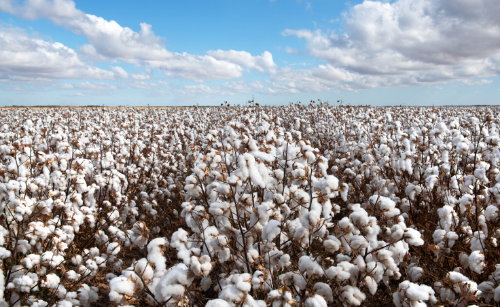According to the United States Department of Agriculture, the United States produces more than 20 million bales of cotton annually, representing more than $7 billion in value to the country’s economy. We are the leading exporter of cotton worldwide, accounting for more than a third of the crop’s global export volume.
Our cotton planting season across 17 southern-tiered states runs from March to June, while the harvest season runs from August to December. While many resources are involved in the production of one of the country’s most important export crops, perhaps none are more important than water.
In the United States, most cotton gets all the water it needs from rainfall. However, choosing the right cotton irrigation systems increases productivity and yield – significantly. In one study that looked at sites across North Carolina and South Carolina, farmers saw a 10% increase in yield in 70% of the years surveyed. In fact, missing out on even one inch of irrigation can reduce fiber yield by 50 pounds per acre!
So, if cotton irrigation is so beneficial, how can farmers ensure that they have the right cotton irrigation methods in place? Let’s talk about it.
How to Irrigate Cotton
For the greatest yield and highest fiber quality, drip irrigation in cotton crop is the way to go. This method, which is sometimes called “precision irrigation,” waters the plant’s roots and not its canopy. This carries a number of advantages. For one thing, humidity levels are not affected, which is of particular importance when the first-floor bolls start to open – the lower the humidity conditions during this period, the higher the lint quality.
Secondly, by applying carefully measured amounts of water, drip irrigation provides farmers with ultimate flexibility and control. Want to create mild stress during certain growth stages for better yield? No problem. Drip irrigation allows farmers to mold the perfect cotton plant, compact with many bolls.
Lastly, drip or precision irrigation offers a greater yield with less water in comparison to conventional furrow, overhead sprinklers, and center pivot irrigation. It yields about 20% more cotton per 1 m3 of water, even under diverse agricultural conditions, without sacrificing lint quality.
How to Optimize Cotton Irrigation in Your Region
With so many different climates and ecological conditions across the U.S., cotton irrigation is far from one-size-fits-all. Luckily, there are several online resources that utilize local weather data to provide accurate, region-specific information. See the Cotton Cultivated Resource Directory for more information about cotton farming in your area.
In addition, if your state isn’t listed, there is an app created by the University of Georgia that uses National Weather Service data to give you a “virtual weather station” on your farm. Find out more and download here.
Cotton Irrigation Management for Humid Regions, a fantastic resource for cotton farmers in humid areas of the Cotton Belt, can be found here.
Cotton is an absolutely vital natural resource across multiple sectors of the U.S. economy, and producers must be mindful of water consumption among many other environmental factors during their production cycle. Drip irrigation is clearly an effective strategy for boosting yields and reducing water waste along the way.
It’s worth noting that current farming methods, including precision irrigation and other aspects of precision farming like the targeted application of fertilizer, conform to a more sustainable model of agriculture than the techniques of yesteryear. Barnhardt is committed to supporting American farmers in their sustainability efforts, as well as continuing to refine our purification process in ways that are more eco-friendly year after year. Producing a better fiber means taking a more sustainably-grown plant and purifying the raw material with a proprietary process involving state-of-the-art mechanical cleaning and a gentle purification wash.
